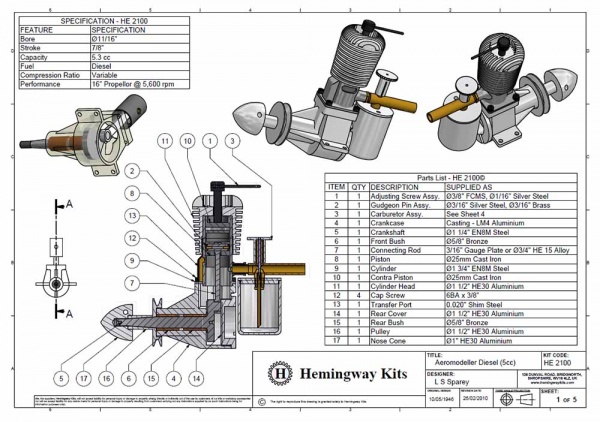| The Aeromodeller Diesels - L H Sparey
The engine designs are "diesels" or more correctly; 2 stroke compression ignition engines. They are best run on a 50/50 mixture of di-ethyl ether and petrol but will burn standard diesel fuel. A contra-piston is fitted, allowing the compression ratio to be tuned once the engine is running. In 1945 the British Air Ministry relaxed its total ban on powered flight for models but set certain regulations, including one that limited engine run-time to 45 seconds per flight. Each engine is fitted with a fairly straight forward carburettor which includes a tiny "fuel tank" to satisfied the standing rules! Both engines share a similar layout based on a single aluminium casting for the crankcase. The cylinder barrel is cut from high tensile steel and the long piston is turned from iron bar. No piston ring is required. The single piece, overhung crankshaft is also machined from high tensile steel and runs in a long bronze main bearing. Whilst the original connecting rod was machined from gauge plate modern constructor generally choose Duraluminium and this material is included in the material kit. The transfer port is made from thin folded sheet and is silver-soldered to the cylinder. There are of course no contact breaker points or cam, no coil and no spark plug! Sparey was a true pioneer of model engines and powered flight and these 2 projects are well known to all IC enthusiasts. Of the two, the larger unit is considered easier to build owing to the size of the components. With a bore x stroke of Ø5/16 x ½" and standing just 3" tall, the 0.63cc unit can spin a Ø7" x 4" propeller at 5,600rpm. The 5.0cc unit stands 4.6" tall with a bore x stroke of Ø11/16" x 7/8" and will swing a Ø16" propeller at 5,600rpm. The Sparey 5cc Diesel in Action
|
 These 2 engine designs were launched within a 12 month period in 1946/7. Owing to their simplicity, Laurence Sparey's diesels went on to become among the most popular IC projects of all time.
These 2 engine designs were launched within a 12 month period in 1946/7. Owing to their simplicity, Laurence Sparey's diesels went on to become among the most popular IC projects of all time.

